“LED strips frequently falling off can result from poor surface prep, ineffective adhesive, or improper installation. Clearly understanding these issues helps you quickly fix and reliably secure your LED strip lights.”
Introduction to LED Strip Adhesion Problems
Having personally installed numerous LED strip lights, I clearly understand how frustrating it can be when LED strips repeatedly fall off. Poor adhesion can diminish lighting effects, compromise safety, and create ongoing maintenance issues.
Why Do LED Strips Fall Off?
LED strips commonly fall off due to inadequate surface preparation, poor-quality adhesive, or improper installation techniques. Clearly identifying these root causes helps you quickly resolve and prevent further issues.
Importance of Addressing Adhesion Issues
Ensuring your LED strips remain securely attached clearly maintains consistent lighting performance, reduces maintenance, and enhances overall safety. Quickly addressing adhesion problems can significantly prolong the lifespan of your LED installations.
Clients often ask me, “Why won’t my LED strips stay securely attached?” Clearly understanding common reasons and quick solutions is essential to maintaining stable, attractive LED lighting.
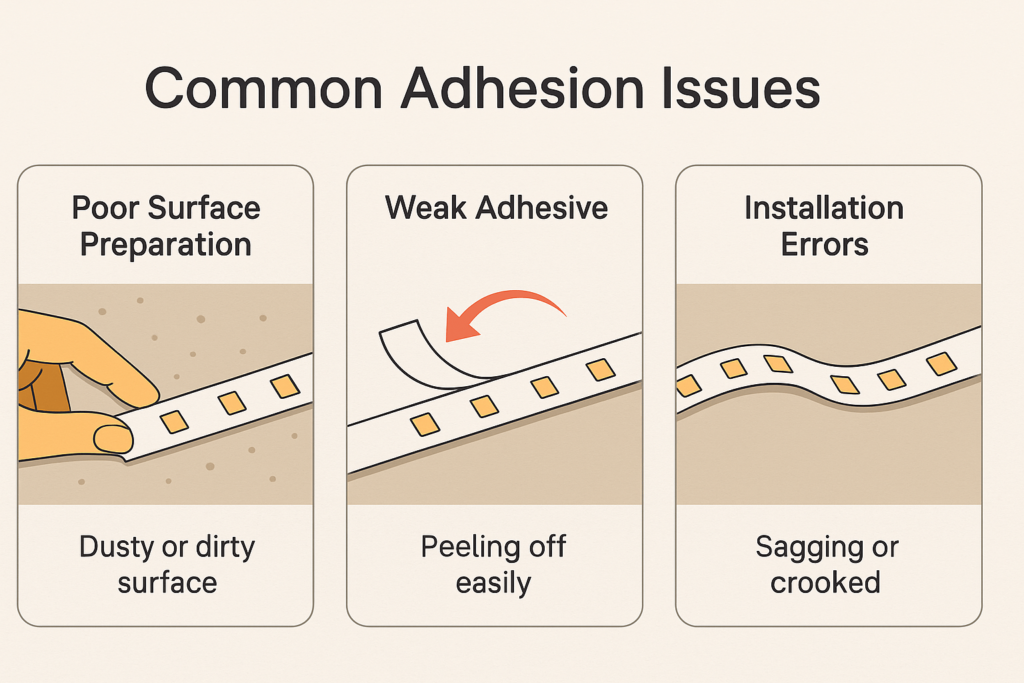
Common Causes of LED Strips Falling Off
Having personally installed many LED strips, I’ve clearly identified common reasons they frequently fall off. Here’s a clear explanation of each issue, so you can quickly recognize and resolve them:
Poor Surface Preparation
- Issue Clearly Explained:
Surfaces that are dusty, oily, uneven, or damp often prevent the adhesive from sticking effectively.
- How to Identify:
LED strips lose adhesion shortly after installation or when touched gently.
Low-Quality or Weak Adhesive
- Issue Clearly Explained:
Cheap or ineffective adhesives provided with some LED strips can fail quickly, causing the strips to peel off easily.
- How to Identify:
Adhesion clearly weakens quickly or the adhesive feels insufficiently sticky upon installation.
Improper Installation Techniques
- Issue Clearly Explained:
Incorrect or rushed installation methods can lead to improperly attached LED strips, causing them to fall off.
- How to Identify:
Strips appear loosely mounted, sagging, or clearly detaching at connection points soon after installation.
Environmental Factors (Heat, Moisture, Humidity)
- Issue Clearly Explained:
Extreme environmental conditions, like heat, humidity, or moisture, can deteriorate adhesive effectiveness over time.
- How to Identify:
Strips clearly detach or lose adhesion in humid, hot, or damp environments.
Comparison Table:
| Causa |
Symptoms |
Quick Solutions |
| Poor Surface Prep |
Strips peel easily |
Proper cleaning and surface prep |
| Low-Quality Adhesive |
Strips detach quickly |
Use stronger adhesive or clips |
| Improper Installation |
Strips sagging or loose |
Follow recommended methods clearly |
| Environmental Factors |
Detachment in humid/hot conditions |
Use aluminum channels or clips |
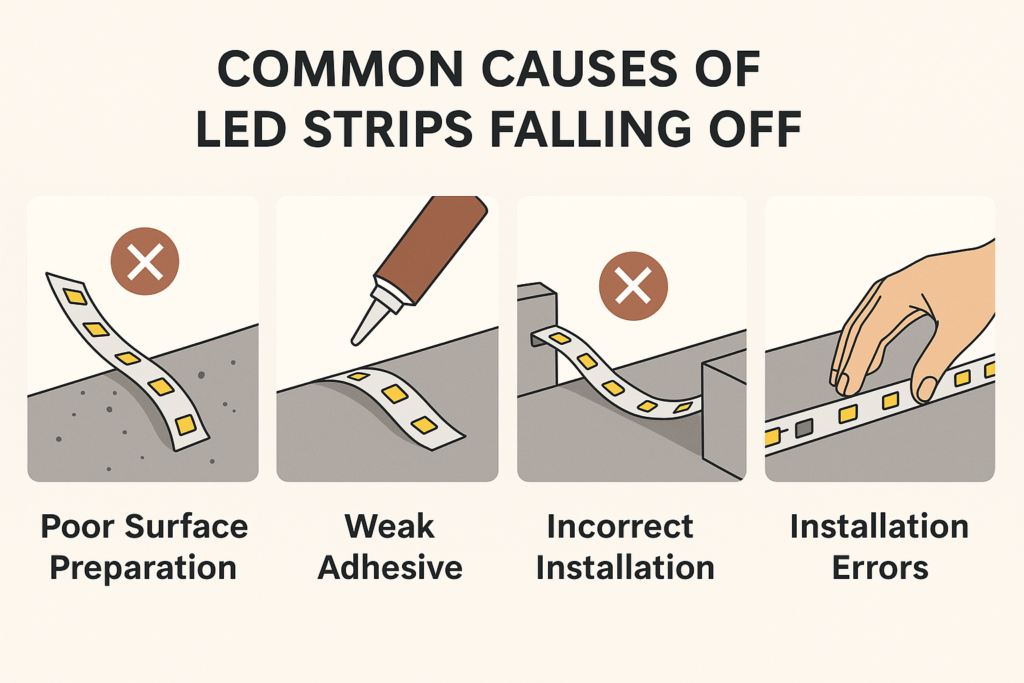
Common Causes of LED Strips Falling Off
From my practical experience installing LED strip lights, I clearly understand the primary reasons why they often fall off. Here’s a straightforward breakdown to help you easily identify and fix these issues:
Poor Surface Preparation
- Description:
Surfaces that are dusty, oily, uneven, or dirty significantly reduce adhesive effectiveness.
- How to Identify:
LED strips clearly detach easily or start peeling off soon after installation.
Low-Quality or Weak Adhesive
- Description:
Inferior adhesive backing fails to maintain proper adhesion, especially under heat or moisture.
- How to Identify:
LED strips clearly lose grip gradually and detach even without external interference.
Incorrect Installation Techniques
- Description:
Improper installation methods or inadequate pressure applied during installation clearly result in weak adhesion.
- How to Identify:
LED strips clearly sag or detach, particularly at corners or bends.
Environmental Factors
- Description:
Excessive humidity, heat, or temperature fluctuations clearly weaken adhesive over time.
- How to Identify:
LED strips clearly detach or sag over time, especially in humid or outdoor conditions.
Comparison Table:
| Edición |
Symptoms |
Quick Solutions |
| Poor Surface Preparation |
Strips peeling soon after installation |
Properly clean and prep surface |
| Low-Quality Adhesive |
Gradual detachment |
Use stronger adhesive or clips |
| Incorrect Installation |
Sagging at bends or corners |
Follow correct installation methods |
| Environmental Factors |
Gradual adhesive weakening |
Use mounting channels or clips |
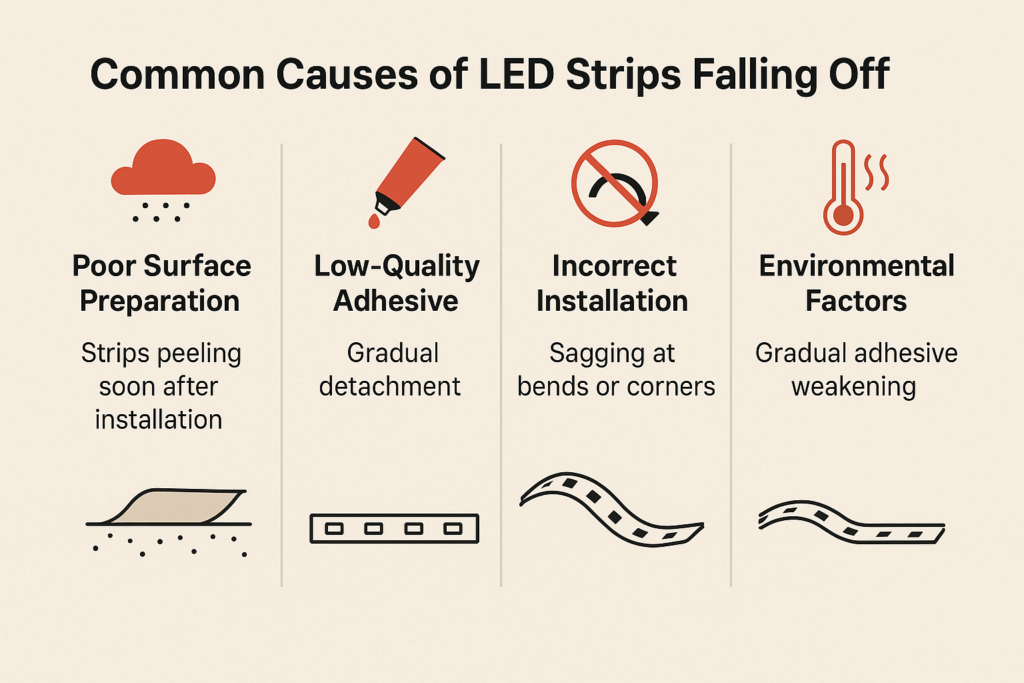
Step-by-Step Guide to Securely Install LED Strips
Drawing from my hands-on experience, here’s a clear, straightforward step-by-step guide to securely installing LED strips and ensuring long-term adhesion:
Step 1: Properly Prepare the Surface
- Thoroughly clean the installation surface with alcohol or a mild cleaning agent.
- Clearly remove dust, dirt, oils, and moisture, ensuring the surface is completely dry before installation.
Step 2: Select Reliable Adhesive or Mounting Method
- Use LED strips with high-quality adhesive backing designed for long-term stability.
- Clearly consider additional support like mounting clips or aluminum channels for extra adhesion security.
Step 3: Correct Installation Techniques
- Clearly apply gentle but firm pressure when attaching the LED strip to the surface.
- Carefully install the strip in straight lines or smooth curves, clearly avoiding sharp bends that weaken adhesive strength.
Step 4: Secure Connections and Endpoints
- Clearly ensure that connection points and endpoints are securely fastened to prevent tension or pulling.
- Use additional connectors or clips to clearly relieve strain from connections and maintain secure placement.
Clients often ask me, “How do I ensure my LED strips remain securely installed?” Clearly, proper surface preparation, using quality adhesives or clips, and correct installation practices ensure stable, long-lasting adhesion.
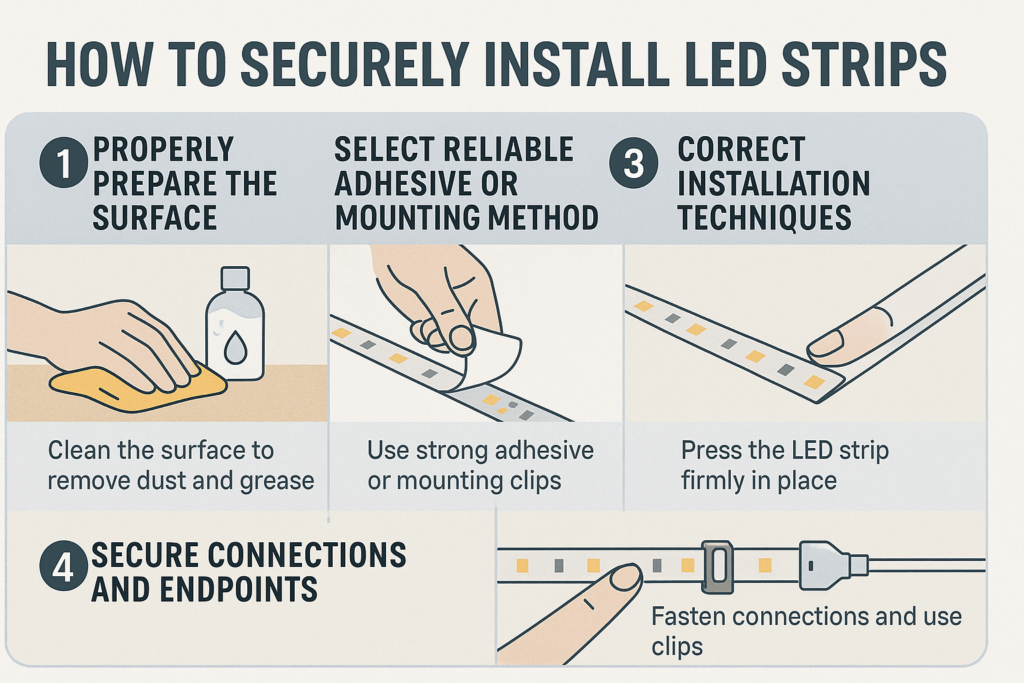
How to Prevent LED Strips from Falling Off
From my extensive experience installing and maintaining LED strips, here’s clear, practical advice to prevent common adhesion issues and keep your LED lighting stable:
Choose Quality Adhesive and Components
- Select LED strips with robust, reputable adhesive backing to clearly ensure strong initial adhesion.
- Clearly consider supplemental methods like mounting clips, aluminum channels, or double-sided adhesive tape for added security.
Thorough Surface Preparation
- Clearly ensure surfaces are clean, dry, smooth, and free of dust or oils before installation.
- Clearly use alcohol wipes or mild cleaning agents to prepare surfaces effectively, enhancing adhesive strength.
Proper Installation Techniques
- Install LED strips carefully, clearly avoiding sharp bends or tension that could weaken adhesion.
- Apply firm, even pressure when adhering strips, clearly improving bond strength and durability.
Regular Maintenance and Inspection
- Clearly schedule routine checks to ensure strips remain secure, proactively reinforcing adhesive or clips as needed.
- Clearly replace or reinforce weakened adhesion points promptly, ensuring continued stable installation.
Clients frequently ask me, “What are easy ways to prevent LED strips from falling off?” Clearly, following these simple guidelines—selecting quality adhesive, proper surface prep, secure installation, and regular maintenance—significantly prevents adhesion issues.
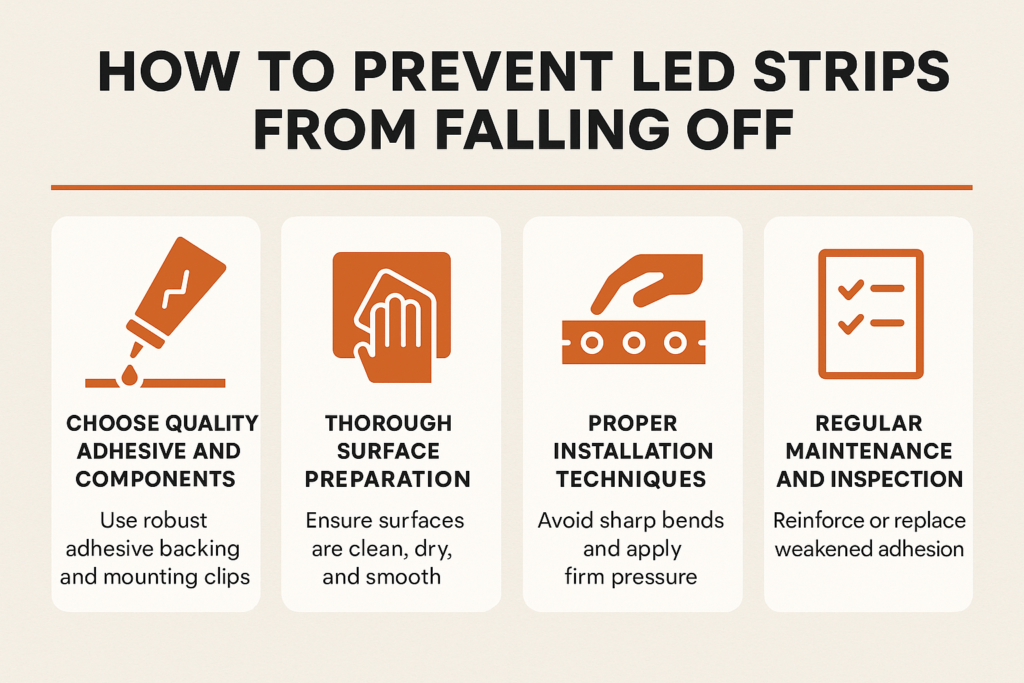
Advanced Tips for Persistent Adhesion Issues
From my personal experience with challenging LED strip installations, I clearly understand how to handle persistent adhesion issues. Here’s straightforward guidance on advanced solutions to ensure LED strips remain securely installed:
Use Mounting Channels (Aluminum Channels)
- Clearly utilize aluminum mounting channels designed specifically for LED strips. These channels securely hold strips, provide better heat dissipation, and ensure consistent, stable adhesion.
Reinforce with High-Quality Mounting Clips
- Clearly reinforce installations with sturdy, reliable mounting clips in addition to adhesive backing. Clips help distribute weight evenly and significantly enhance adhesion reliability.
Apply Heavy-Duty Double-Sided Tape
- For challenging surfaces or persistent adhesion issues, clearly consider using heavy-duty double-sided adhesive tape designed explicitly for LED strips and other electronic installations.
Seal Ends and Connection Points
- Clearly seal strip ends and connection points with silicone adhesive or specialized waterproof caps, particularly in outdoor or moisture-rich environments, to prevent adhesive weakening.
Clients often ask me, “How can I securely install LED strips that keep falling off?” Clearly, advanced measures like mounting channels, reliable clips, and high-quality adhesive tapes help effectively solve persistent adhesion issues.

Recommended Components & Tools for Secure LED Installation
From my extensive experience installing LED strips, I clearly understand how critical it is to select high-quality components and reliable tools. Here’s straightforward guidance on recommended items to ensure your LED strips stay securely in place:
High-Quality LED Strips
- Clearly choose LED strips from reputable manufacturers with proven adhesive backing quality, ensuring stable, reliable performance.
Robust Mounting Clips
- Clearly select sturdy mounting clips designed specifically for LED strips, providing additional support to adhesive backing and preventing detachment.
Aluminum Mounting Channels
- Clearly use aluminum channels for mounting LED strips, offering secure attachment, enhanced heat dissipation, and professional appearance.
Reliable Adhesives and Double-Sided Tape
- Clearly select high-quality, heavy-duty adhesives or double-sided tape explicitly designed for electronic installations, ensuring long-term stability.
Essential Installation Tools
- Clearly have essential tools like a voltage meter (multimeter), wire cutters, and soldering kit readily available for secure and reliable LED strip installations.
Clients frequently ask me, “What components and tools do I clearly need to securely install LED strips?” Clearly, choosing quality LED strips, reliable mounting clips, aluminum channels, and strong adhesives helps ensure stable, long-lasting adhesion.

Expert Maintenance & Long-term Care Recommendations
Having personally installed and maintained many LED strip systems, I clearly understand the importance of proper care to maintain long-lasting, stable installations. Here’s clear, practical guidance on maintenance to ensure your LED strips remain securely installed over time:
Regular Visual Inspections
- Clearly schedule regular inspections to verify LED strips remain firmly attached, especially at connection points and bends.
- Quickly reinforce or replace adhesives or mounting clips at the first signs of weakening.
Gentle Cleaning Practices
- Clearly perform gentle cleaning periodically using a soft cloth to remove dust or dirt, maintaining adhesive effectiveness and lighting quality.
- Clearly avoid harsh cleaners or solvents that could degrade adhesive backing or strip integrity.
Heat and Environmental Management
- Clearly ensure adequate heat dissipation, using aluminum channels or heat sinks, especially for high-brightness installations, to prevent adhesive weakening caused by heat buildup.
- Clearly monitor environmental conditions such as moisture, heat, and humidity, adjusting installation methods accordingly for better stability.
Reinforcement and Replacement as Needed
- Clearly reinforce adhesives with mounting clips or additional double-sided adhesive tape, particularly in high-traffic or moisture-rich areas.
- Promptly replace sections clearly showing persistent adhesion failure or material degradation.
Clients frequently ask me, “How often should I maintain my LED strips to avoid adhesion problems?” Clearly, performing routine checks every few months and gentle cleaning at least twice annually significantly enhances adhesion reliability and long-term stability.
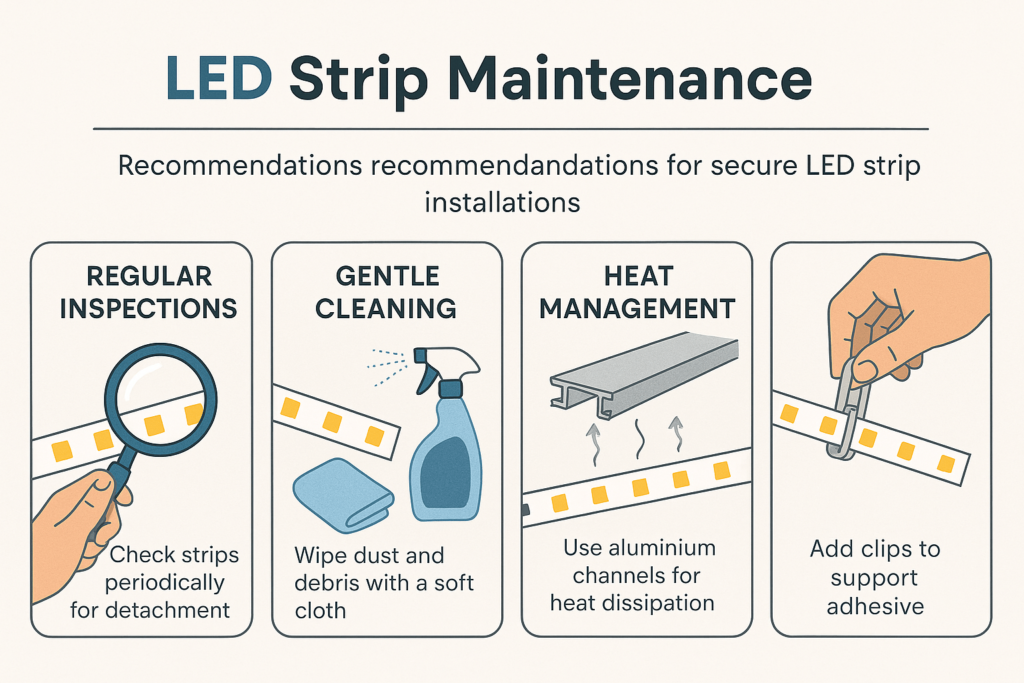
FAQs About LED Strip Adhesion Issues
Drawing from my personal experience installing and troubleshooting LED strip lights, here are clear, practical answers to frequently asked questions about adhesion problems, helping you easily resolve and prevent future issues:
Why do my LED strips keep falling off?
Common reasons include inadequate surface preparation, low-quality adhesive, environmental conditions (heat, humidity), or improper installation. Clearly addressing these issues quickly ensures stable adhesion.
What is the best adhesive for LED strips?
Clearly, heavy-duty double-sided tape, high-quality adhesive backing, or additional mounting clips provide the strongest, most reliable adhesion for LED strips.
Can I reuse LED strips after they fall off?
Yes, you can often reuse LED strips. Clearly remove old adhesive carefully, thoroughly clean the surface, and reapply fresh high-quality adhesive or use mounting clips for reliable reinstallation.
Conclusion & Next Steps
Clearly understanding the reasons behind LED strip adhesion issues and how to quickly fix and prevent them ensures your lighting remains stable, reliable, and visually appealing. Based on my hands-on experience, proper surface preparation, selecting quality adhesives, and secure installation practices significantly reduce the likelihood of LED strips falling off.
Proactively following these practical guidelines, regularly inspecting your installation, and conducting proper maintenance will help you maintain secure, attractive LED strip lighting over the long term.
Ready to ensure your LED strips stay securely installed?
Explore Elstar’s LED Lighting Solutions →









